 A close-up of one block...and the story of how it came to be.
A close-up of one block...and the story of how it came to be.
I won the Marti Michell Perfect Patchwork Template set for Drunkard's Path style blocks in Karen's give away and was thrilled. Practically since I began quilting 20 years ago, I've wanted to make a Drunkard's Path quilt, a two color quilt and a yellow quilt and more recently Ive become attracted to big block or 4-block quilts. Here was my chance to do all of it! (BTW, there are block diagrams included in the template set for other blocks too!)
I decided to take you along and show you how I used these great templates: so here's my tutorial on using the Marti Michell Template set. ( BTW, block diagrams for blocks other than Drunkards Path are included with the templates.) I hope you can see these photos well-please let me know if you can't.
I already had enough yellow and white fabric and the template set, all I needed was the small rotary cutter which I got at my local quilt shop.
 This set is the large size template set. For the convex piece-the pie piece- you cut a strip of fabric 5 1/2" wide by the width of the fabric. You do not need to open the strip-just trim off the selvage and lay the template flat on the strip, aligning the left side and the bottom with the cut edges and with the small rotary cutter, cut through all four layers of fabric.
This set is the large size template set. For the convex piece-the pie piece- you cut a strip of fabric 5 1/2" wide by the width of the fabric. You do not need to open the strip-just trim off the selvage and lay the template flat on the strip, aligning the left side and the bottom with the cut edges and with the small rotary cutter, cut through all four layers of fabric.

Flip the template so that the bottom edge aligns with the top of the strip and cut-this time around the curve and down the straight edge.

Voila! Eight pie shape pieces cut-that's enough from one color fabric for all that color pieces in 1 block. (Since I was making 4 blocks, I repeated this with 3 more white strips and then for 4 yellow strips.)

For the other side of the unit, the concave piece, you have a choice as to the size you want to use. You cut squares and then use the template-the size of your original square is the size of the drunkard's path unit and determines the size of your finished block. Starting with a 6 1/2" square, you get a finished block size of 24", a 7" square yields a 26" block and a 7 1/2" square yields a 28" block-that was my choice and the largest size recommended. Hey, if I'm making a big block, I'm making a big block!
 This set is the large size template set. For the convex piece-the pie piece- you cut a strip of fabric 5 1/2" wide by the width of the fabric. You do not need to open the strip-just trim off the selvage and lay the template flat on the strip, aligning the left side and the bottom with the cut edges and with the small rotary cutter, cut through all four layers of fabric.
This set is the large size template set. For the convex piece-the pie piece- you cut a strip of fabric 5 1/2" wide by the width of the fabric. You do not need to open the strip-just trim off the selvage and lay the template flat on the strip, aligning the left side and the bottom with the cut edges and with the small rotary cutter, cut through all four layers of fabric.
Flip the template so that the bottom edge aligns with the top of the strip and cut-this time around the curve and down the straight edge.

Voila! Eight pie shape pieces cut-that's enough from one color fabric for all that color pieces in 1 block. (Since I was making 4 blocks, I repeated this with 3 more white strips and then for 4 yellow strips.)

For the other side of the unit, the concave piece, you have a choice as to the size you want to use. You cut squares and then use the template-the size of your original square is the size of the drunkard's path unit and determines the size of your finished block. Starting with a 6 1/2" square, you get a finished block size of 24", a 7" square yields a 26" block and a 7 1/2" square yields a 28" block-that was my choice and the largest size recommended. Hey, if I'm making a big block, I'm making a big block!
Here you can see I'm cutting the 7 1/2" square from a strip that is 4 layers of fabric...

and then immediately laying down the template, aligning the straight side and bottom of the template with the left corner of the fabric square....

and cutting around the template. I repeated this process until I had all 32 white pieces and then I did it again with the yellow fabric. Its went quickly-cutting 4 layers at a time- but I suppose I could have been a bit more adventurous and tried 8 layers!
 BTW, you can use these templates even if you don't have a small rotary cutter. Lay the template down, the same way as I did but draw around the curved edge. I find its best to use a mechanical pencil so that your line is always the same thickness. (Remember to hold your pencil at an angle to your fabric so it writes smoothly.)
BTW, you can use these templates even if you don't have a small rotary cutter. Lay the template down, the same way as I did but draw around the curved edge. I find its best to use a mechanical pencil so that your line is always the same thickness. (Remember to hold your pencil at an angle to your fabric so it writes smoothly.)

Here you can see I'm cutting on the marked line with fabric scissors.

See, the pieces look exactly the same...but remember I was able to cut 4 layers of fabric at a time with the rotary cutter and only 1 layer with the scissors.

I've shown how to cut the pieces using just the white fabric. Now that I'm going to show you how I sewed the units, in all the following photos, I used the yellow fabric for the "L" shaped piece (the concave curve) and the white fabric for the pie piece.

and then immediately laying down the template, aligning the straight side and bottom of the template with the left corner of the fabric square....

and cutting around the template. I repeated this process until I had all 32 white pieces and then I did it again with the yellow fabric. Its went quickly-cutting 4 layers at a time- but I suppose I could have been a bit more adventurous and tried 8 layers!
Here's the cut pieces. You discard the bottom pie-like piece (or save it to use later-I'll post about what I do with them when I do something, right now they're just stacked up on a shelf!).
See how wide the fabric is above the curve on the top "L" shaped piece-that's because I started with a 7 1/2" square. The smaller 6 1/2" square would have less fabric above the curve.
 BTW, you can use these templates even if you don't have a small rotary cutter. Lay the template down, the same way as I did but draw around the curved edge. I find its best to use a mechanical pencil so that your line is always the same thickness. (Remember to hold your pencil at an angle to your fabric so it writes smoothly.)
BTW, you can use these templates even if you don't have a small rotary cutter. Lay the template down, the same way as I did but draw around the curved edge. I find its best to use a mechanical pencil so that your line is always the same thickness. (Remember to hold your pencil at an angle to your fabric so it writes smoothly.)
Here you can see I'm cutting on the marked line with fabric scissors.

See, the pieces look exactly the same...but remember I was able to cut 4 layers of fabric at a time with the rotary cutter and only 1 layer with the scissors.

I've shown how to cut the pieces using just the white fabric. Now that I'm going to show you how I sewed the units, in all the following photos, I used the yellow fabric for the "L" shaped piece (the concave curve) and the white fabric for the pie piece.
When sewing curves, I find it much easier to pin if I have some guides (like notches on a clothing pattern). There are no holes in these templates to use to make a pencil dot guide so I simply folded the fabric and made creases for guides.
Here's how: fold the "L" shaped piece in half, aligning the squared corners and the straight edges. Pinch with your fingers to make a crease.

Now, fold it in half again and pinch.

Here you can see the creases. They don't go all the way down, just about 1/2" from the curved edge...just enough.

I did the same thing with pie piece. First folding it in half...

Here you can see the creases on this white pie piece.

I then laid the yellow "L" piece on the white pie piece, aligning the center creases and pinned.

Then I aligned the corners and pinned...

and then I aligned the creases between the center and corner pins...and pinned.

Then I smoothed out the fabric and aligning the cut edges, pinned between the pins....yes, for curves I use alot of pins.

Then it was off to the sewing machine. I slowly sewed so that I could easily make sure that I wasn't getting at tucks. I then pressed all the seam allowance towards the "L" piece.
Here's a finished Drunkard's Path unit. Sewing the units together is very easy-just like sewing plain squares of fabric together!

Now, fold it in half again and pinch.

Here you can see the creases. They don't go all the way down, just about 1/2" from the curved edge...just enough.

I did the same thing with pie piece. First folding it in half...

Here you can see the creases on this white pie piece.

I then laid the yellow "L" piece on the white pie piece, aligning the center creases and pinned.

Then I aligned the corners and pinned...

and then I aligned the creases between the center and corner pins...and pinned.

Then I smoothed out the fabric and aligning the cut edges, pinned between the pins....yes, for curves I use alot of pins.

Then it was off to the sewing machine. I slowly sewed so that I could easily make sure that I wasn't getting at tucks. I then pressed all the seam allowance towards the "L" piece.
Here's a finished Drunkard's Path unit. Sewing the units together is very easy-just like sewing plain squares of fabric together!





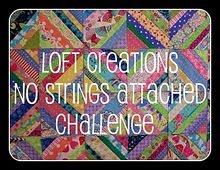
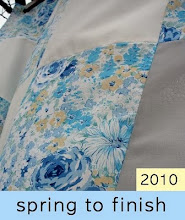




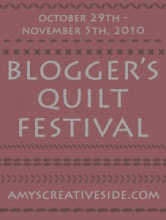
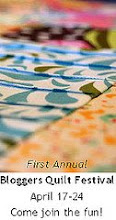


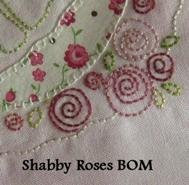



15 comments:
Miri I am so glad to see that the templates worked out so great for you. I still have some templates even though I have give two sets away! Your tutorial is great!
Karen
http://karensquilting.com/blog/
I am so in awe of your ability to sew those curved seams. I get so frustrated any time I try, that I have pretty much decided that I will only do straight line piecing.
I am going to start some 3.5" drunkard's path squares and am going to print out your tutorial to help me. thanks
Nice tutorial, Miri. I use the crease method too. Can't wait to see how you finish it.
You make it sound so easy!
What a wonderful win and tutorial!
I LOVE the Drunkard's Path design and this is so pretty done in two colours. I am planning to make another one in pale pink and cream. Your tutorial was excellent, thank you.
Miri,
Thank you for visiting me. Your work is beautiful. Love the curve piecing.
fun quilt and great tutorial.
A realy beautiful quilt and round shapes is truly a challenge I have tried myself.
That is SO pretty. It looks complicated, but you did a great job on it. Thanks for sharing your creativity and talent.
Drunkard's path is on my list. I want to make a red and white one. Thanks for the great tutorial!
Thank you for a great post with good photos. I am confused though and I hope you can clear this up for me: 4 blocks 7.5" ea. yield one larger square that is 14.5" on ea. side ... no? How do you get 28"? Thanks so much!
Good of you to write, Eli, thanks so much for the kind words about my work. I get it now--I was indeed thinking a finished block consisted of 4 smaller ones. Thanks!
Post a Comment